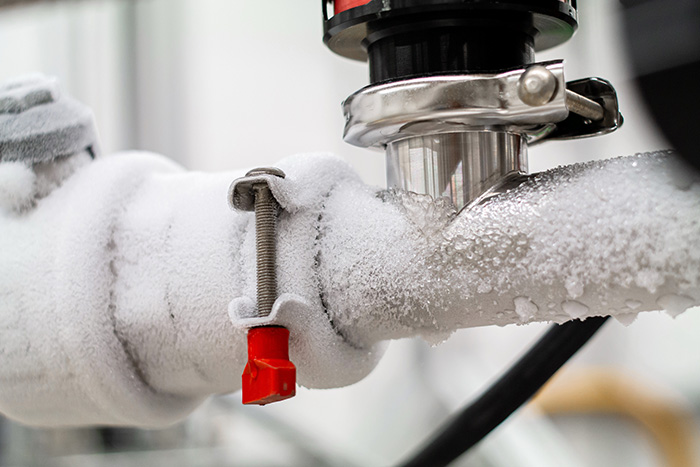My AC Pipe Is Frozen Solid - What Do I Do? Guidance for Remedy
My AC Pipe Is Frozen Solid - What Do I Do? Guidance for Remedy
Blog Article
Each person maintains their own opinion involving How can I fix an air conditioner’s frozen pipe?.

Introduction
Finding that your AC pipeline is iced up can be concerning, especially during hot summer months when you rely on your air conditioning system the most. Comprehending what to do in such a circumstance is crucial to stop further damages to your cooling system and guarantee your comfort inside.
Understanding the Causes
A number of factors can add to the cold of an air conditioner pipeline. Recognizing these reasons can help you deal with the problem properly.
Lack of Airflow
One typical reason for a frozen AC pipe is inadequate air flow. When the air movement over the evaporator coil is limited, it can create the coil to go down below freezing temperature level, resulting in ice development on the pipeline.
Reduced Refrigerant Levels
Inadequate cooling agent degrees in your air conditioner system can likewise result in a frozen pipe. Low cooling agent degrees can trigger the pressure in the system to drop, bring about the cold of moisture on the evaporator coil.
Cold Weather Conditions
In chillier climates, freezing temperature levels outside can contribute to the freezing of a/c pipelines. If your AC unit is not properly shielded or if there are leakages in the ductwork, chilly air can penetrate the system, creating the pipe to freeze.
Dirty Air Filters
Unclean or clogged air filters can restrict air flow in your AC system, resulting in numerous concerns, including a frozen pipe. It's important to change or clean your air filters regularly to guarantee proper airflow and protect against ice buildup.
Signs of a Frozen Air Conditioning Pipe
Identifying the signs of a frozen air conditioner pipeline is crucial for prompt action.
Lowered Airflow
If you see a considerable reduction in air flow from your vents, it can indicate a frozen pipe.
Ice Buildup on the Pipe
Visible ice buildup on the refrigerant line or the evaporator coil is a clear indicator of an icy a/c pipe.
Unusual Sounds from the Unit
Unusual audios, such as hissing or bubbling, coming from your air conditioning system can signify that there's ice present on the pipe.
Immediate Actions to Take
When confronted with an icy AC pipe, it's vital to act promptly to stop further damages to your air conditioning system.
Switching off the AC
The first step is to turn off your air conditioning system to avoid the system from running and intensifying the issue.
Looking for Blockages
Examine the location around the interior device for any obstructions that may be blocking air flow, such as furnishings or drapes.
Defrosting the Pipe
You can make use of mild approaches like putting towels soaked in warm water around the icy pipe to help thaw it gradually.
Safety nets
Taking safety nets can assist avoid future occurrences of an icy air conditioning pipeline.
When DIY Methods Fail
If your efforts to thaw the pipeline or address other problems are not successful, it's time to call an expert.
Significance of Hiring a Professional HVAC Technician
A licensed HVAC professional has the knowledge and tools essential to identify and fix problems with your a/c system securely and effectively.
Normal Maintenance Checks
Set up regular upkeep contact an expert HVAC professional to make sure that your a/c system is running efficiently.
Transforming Air Filters
Consistently change or clean your air filters to avoid airflow restrictions and keep ideal performance.
Shielding Exposed Pipes
If your AC pipes are revealed to cool temperatures, think about shielding them to prevent cold throughout cold weather.
Looking For Professional Help
If DIY techniques fail to solve the problem or if you're uncertain regarding just how to proceed, it's ideal to seek aid from a qualified HVAC professional.
Verdict
Taking care of an icy AC pipe can be a frustrating experience, however recognizing how to react can help reduce damages and recover convenience to your home. By recognizing the reasons, identifying the signs, and taking prompt action, you can efficiently deal with the concern and protect against future occurrences.
What to Do If Your AC Line Is Frozen
Make Sure All Supply and Return Air Vents Are Open
If you notice problems with airflow, the first thing you should do is check your supply and return vents. Supply vents distribute clean, conditioned air throughout your home. As this air becomes stale, it’s pulled into the return vent, where it’s reconditioned before being sent back out through the supply vent.
When these vents are closed, air won’t flow in the home. Before examining your AC, check the vents in every room and ensure they’re all open.
Check for a Dirty Air Filter
Another possible cause of limited airflow is a dirty air filter. Your air conditioner’s filters catch elements you don’t want to breathe in, such as dirt and dust. Over time, filters can become clogged, ultimately blocking air from flowing in and out. The lack of airflow can then cause the entire coil to freeze and will completely restrict any air from moving through it. The AC may need to be powered off for one to two days to allow the coil to thaw after replacing the filter to allow proper functioning of the unit. This debris can also accumulate on your AC’s evaporator coil, requiring a more serious repair. In general, air filters should be cleaned regularly (about every two weeks).
Assess Your Outdoor Unit
In addition to checking your AC, assessing the outdoor unit is a good idea. Also known as the condensing unit, it works with your interior unit to release heat outside. An issue with the outdoor unit can result in rising internal temperatures.
Overgrown Shrubs or Clogged Leaves
From leaves and twigs to shrubs and debris, there’s no shortage of outdoor elements that can accumulate around your condensing unit. When these elements get lodged inside the unit, they can block airflow. Fortunately, removing the blockage can solve the problem.
Sounds of a Broken Fan
Shrubs and leaves aren’t the only things that can impede your outdoor unit’s airflow. If the fan is broken, the unit won’t be able to properly get rid of heat — which means the internal temperature won’t go down. First, make sure the fan is spinning. If it is, check for the following sounds of a broken fan:
Buzzing Rattling Screeching Hissing Clicking Preventative Measures
Nobody wants to deal with a frozen AC line. In addition to causing problems with your air conditioner, they require professional repairs. On the bright side, there are preventative measures you can take to help ensure this issue doesn’t arise in the first place.
https://www.coopergreenteam.com/blog/what-to-do-if-ac-line-frozen

Hopefully you enjoyed our section about Have a Frozen AC Line? Here’s How to Fix It. Thanks for taking the time to read through our article. Sharing is caring. You never know, you may be doing someone a favor. We enjoy reading our article about Why Is Ice On My Outside Air Conditione.
Get Started Report this page